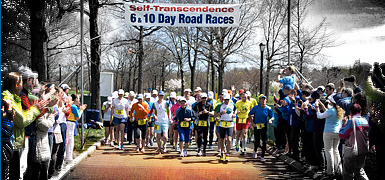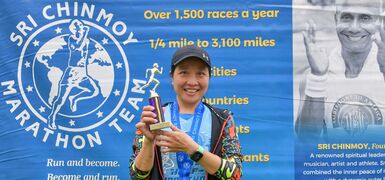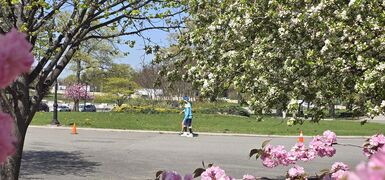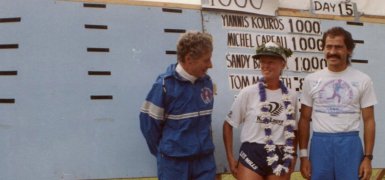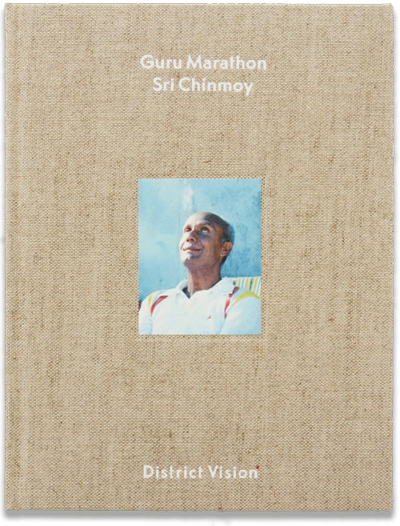In the 1988 IAU newsletter, Malcolm Campbell gives the following detailed history of multiday running in the 1980s.
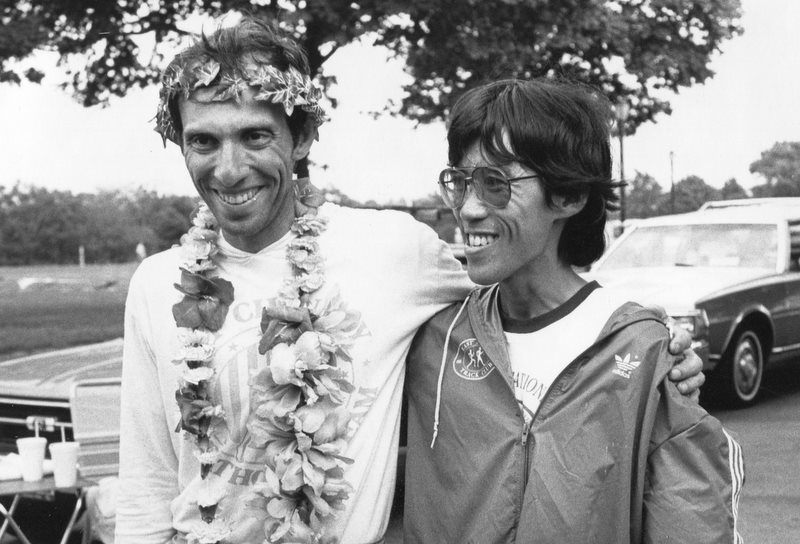
Trishul Cherns (l) and Don Choi in the 1985 Sri Chinmoy 1,000 Mile Race
"In a recent publication the last three words of a quotation by Jim Shapiro were omitted. The full quotation is:
‘It is not pain I feel but sinking.
My involvement with the world grows dimmer.
It occurs to me that it would be nice to keel over.
A barely audible whisper says it would be a way out.
It seems almost impossible to bother any more...
But I do!’
The words appeared in Jim’s book ‘Ultramarathon’ which was published in 1980, and tells the story of Ultrarunning up to the end of the 1970s. The multi day event was just about to take off and Jim had noticed this when he wrote ‘In 1979, Don Choi organized two 48 hour runs in California. Mutterings are occasionally heard from Tom Osler in New Jersey about possibly staging a 6 day wobble.’ I very much hope that Jim will write another book because the events of the 1980s are well worth recording. The first 6 day race of modern times took place in Woodside, California in July of 1980, and was won by Don Choi with 401 miles. The first Edward Payson Six Day Track Race took place a few weeks later in Pennsauken, Philadelphia. Don Choi was the winner again with 425 miles. The following year in Pennsauken, Park Barner completed 430 miles.
The development of the sport depended on the willingness of the runners to participate and the willingness of organizers to stage these very demanding events. Sponsors were available but they had to be educated concerning the athletic possibilities of modern day runners. To some extent the growth of the sport sprang from chance remarks or accidental meetings of interested parties. One runner in the 1981 Pennsauken Race who played a vital part in the growth was Geoff Richardson, a Scot working in America. Shortly after the race finished he returned to England determined to stage a similar event, and with the aid of three good friends, the first Nottingham Six Day race was organized. The winner was Mike Newton who became the first runner of modern times to pass the 500 mile mark. Multi day racing owes much to Mike Newton. Most established ultra runners in England were reluctant to take chances on a new event and many thought the race was doomed to failure. How wrong they were. Don Choi, Jim Shapiro and Wes Emmons came over from America. The Canadian, and Olympian, Paul Collins entered and Joe Record from Australia took part. The media loved the event and sponsorship was assured for a number of years.
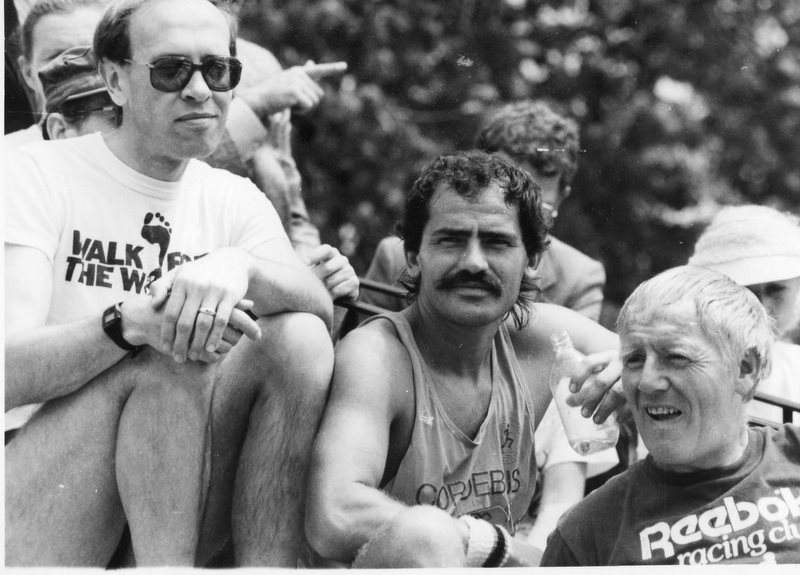
(l to r) Richard Brown, Yiannis Kouros and author Malcolm Campbell prior to 1988 Ultra Trio
In 1982, the Nottingham race was won by Tom O’Reilly with 576 miles and a new modern day record. At this point, students of ultra distance running were noting that in the 1980s there were a number of performances over 600 miles and that George Littlewood’s record of 623 miles and 320 yards, set at Madison Square Garden in 1880 was far beyond the capabilities of modern day runners. The race was now on to be the first to beat this record and the subject aroused worldwide interest. News of the event had spread to France, a country with a long standing tradition of distance running, and a Six Day Indoor Race was staged at la Rochelle in 1982; the race winner was Ramon Zabalo with 537 miles. The Nottingham Six Day Race was held annually from 1981 to 1985. The La Rochelle Race has been held annually from 1980. The Six Day Race is also firmly established at Colac in Australia where some outstanding performances have been achieved.
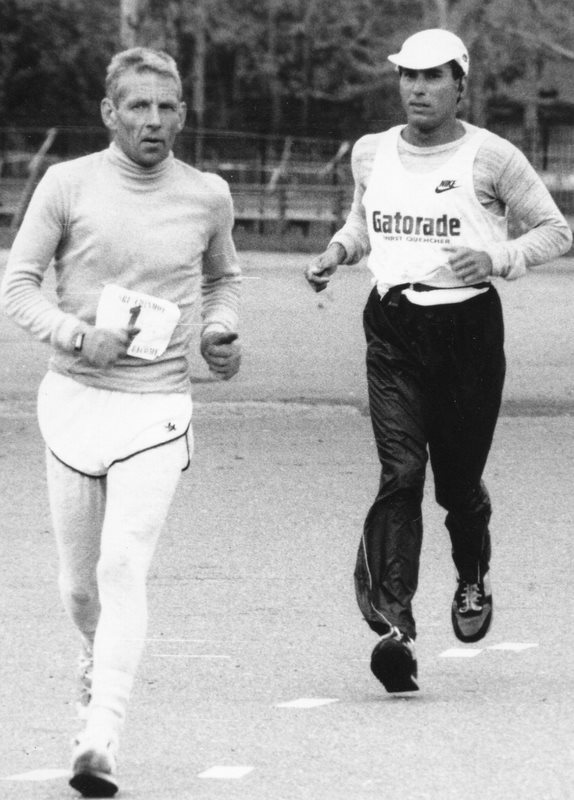 Fred Lebow took an interests in the Six Day Race and became determined that the first man to best Littlewood's record would do so in New York. The New York Road Runners club organized two Six Day Races and the first of these was held in 1983. The race winner, Siegfried Bauer, completed 511 miles which was a better performance than the mileage indicates. The temperature during the entire race was particularly hot.
Fred Lebow took an interests in the Six Day Race and became determined that the first man to best Littlewood's record would do so in New York. The New York Road Runners club organized two Six Day Races and the first of these was held in 1983. The race winner, Siegfried Bauer, completed 511 miles which was a better performance than the mileage indicates. The temperature during the entire race was particularly hot.
The following year, Lebow signed up Kouros and Ramon Zabalo and the ancient record (Littlewood's record) was finally beaten when Kouros added a few yards to his World Record and Zabalo completed 593 miles.
In many ways, 1984 marked the end of an era. There would be other good performances over six days, but no other runner would pass Littlewood’s mark, and only two runners would pass the 600 mile mark. Stu Mittleman ran 577 miles at Boulder County, and Patrick Macke ran 579miles at La Rochelle. The great French runner, John Gilles Boussiquet, ran 605 miles at La Rochelle in 1984, and the following year his fellow countryman, Gilbert Mainnix ran 609miles at the same venue. The highlight of Eleanor Adam’s career came at Colac in 1987 when she beat her own World Record with 521 miles.
After Littlewood’s record was beaten a number of major sponsors lost interest in the event. It became difficult to justify the considerable travelling expenses involved for competitors who, at their best, would be unable to complete distances that had been achieved over 100 years ago. In 1982 Cliff Young, a 62 year old farmer, won the inaugural Sydney to Melbourne foot race. He achieved worldwide publicity and became a National Hero, and the race was assured of a place in Australian history. Westfields Corporation realized the publicity value of the race, and it has become the most costly event on the ultra running calendar.
The Westfield run was dominated, as the six day race had been dominated, by Kouros and in 1987 he completed the 1060 KMs between Sydney and Melbourne in a time of 5 days, 14 hours and 47 minutes; he was nearly 26 hours in front of the second place runner. Quite clearly, the sponsors of other runners could be forgiven for wondering if they were getting value for their investment. 1988 was Australia’s Bi-Centenary Year and the Westfield organizers were determined to make maximum use of the publicity for the event. The course was altered slightly and the new distance was measured as 1015 KMs. Yiannis Kouros was persuaded to accept a 12 hours handicap and started at 23.00 hours, whilst the rest of the field started beforehand at 11.00 hours. A number of runners expressed some concern at the arrangements, but in fact Kouros was paying them a great compliment in only giving them 12 hours start. In any event, he overhauled the entire field and finished about 4 hours ahead of second place Richard Tout. The handicap made his race time 6 days, 7 hours, 14 minutes. Richard Tout’s time was 6 days, 11 hours, 18 minutes. Although there are no serious challengers to Kouros over six days, it seems likely that Richard Tout presents the greatest threat to the supremacy of this great Greek athlete.
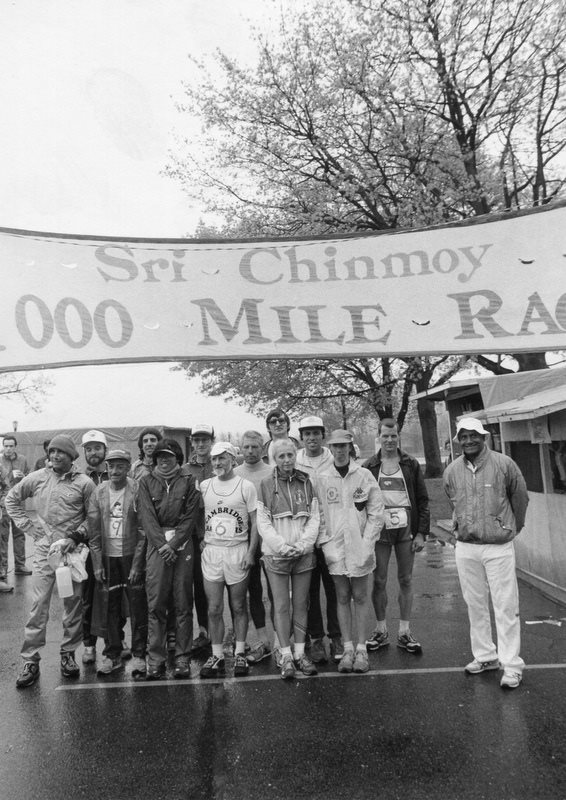 Meanwhile, a new event had emerged on the multi day calendar. The 1,000 mile race! In the 1970s there had been a two-man challenge between John Ball of South Africa and Siegfried Bauer from New Zealand. Bauer won this race which took place in South Africa and he was to win over the same distance in Colac (Australia) in 1983 with a time of 12 days, 12 hours, 36 minutes. This race started in Melbourne and the competitors ran to Colac, a distance of about 92 miles, where they continued around an accurately marked circuit in the Memorial Square of the Town. In 1985, the Sri Chinmoy Marathon Team in New York organized a 1,000 mile road race in Flushing Meadows Park, Queens, New York. That great pioneer of multi day racing, Don Choi, was still around and it seemed most appropriate that he should win this inaugural event. His winning time was 15 days, 6 hours, 24 minutes. In the same year, a 1,000 mile track race at Gateshead in England was won by Malcolm Campbell with a time of 15 days, 21 hours, 7 minutes. This had been the first 1,000 mile track race for nearly a century and, unlike the old 6 day records, the old 1,000 mile track times were quite modest. The Australian runner, Tony Rafferty, won a 1,000 mile road race in England in 1986 with a time of 14 days, 16 hours, 45 minutes. An outstanding 1,000 mile run was produced by the American, Stu Mittleman, at Flushing Meadow (a Sri Chinmoy Marathon Team race) in 1986 when he finished 25 hours in front of the second place runner with a time of 11 days, 20 hours, 37 minutes. Mittleman’s record for 1,000 miles seemed secure against all known competitors over the distance, and posed certain questions for outstanding performers over lesser distances.
Meanwhile, a new event had emerged on the multi day calendar. The 1,000 mile race! In the 1970s there had been a two-man challenge between John Ball of South Africa and Siegfried Bauer from New Zealand. Bauer won this race which took place in South Africa and he was to win over the same distance in Colac (Australia) in 1983 with a time of 12 days, 12 hours, 36 minutes. This race started in Melbourne and the competitors ran to Colac, a distance of about 92 miles, where they continued around an accurately marked circuit in the Memorial Square of the Town. In 1985, the Sri Chinmoy Marathon Team in New York organized a 1,000 mile road race in Flushing Meadows Park, Queens, New York. That great pioneer of multi day racing, Don Choi, was still around and it seemed most appropriate that he should win this inaugural event. His winning time was 15 days, 6 hours, 24 minutes. In the same year, a 1,000 mile track race at Gateshead in England was won by Malcolm Campbell with a time of 15 days, 21 hours, 7 minutes. This had been the first 1,000 mile track race for nearly a century and, unlike the old 6 day records, the old 1,000 mile track times were quite modest. The Australian runner, Tony Rafferty, won a 1,000 mile road race in England in 1986 with a time of 14 days, 16 hours, 45 minutes. An outstanding 1,000 mile run was produced by the American, Stu Mittleman, at Flushing Meadow (a Sri Chinmoy Marathon Team race) in 1986 when he finished 25 hours in front of the second place runner with a time of 11 days, 20 hours, 37 minutes. Mittleman’s record for 1,000 miles seemed secure against all known competitors over the distance, and posed certain questions for outstanding performers over lesser distances.
In six day races there are competitors who run quite slowly to achieve great distances by not sleeping very much. Others run quite briskly but rest more often. There are a few exceptional performers who are able to manage with very little sleep and are still able to run well. These are, of course, the Champions. However, their ability to manage with virtually no real sleeping periods has only been tested over 6 days. They are not certain to manage for 10 days without a ‘trade off’ – and thereby lies the interest of the 1,000 mile race.
Eleanor Adams won a 1,000 mile stage race in England in 1987 with an overall time of 16 days, 23 hours, 9 minutes, and this was the best time ever recorded by a lady over the distance. One can only imagine the time Eleanor Adams might achieve in a ‘go as you please’ event and she has done much to encourage the increase in standards of lady multi day runners, and like Don Choi, must be considered one of the truly great pioneers of the sport.
 This article was started before the Sri Chinmoy 1,000 mile race took place in New York. The race started on 20th May 1988 and Yiannis Kouros was to become the IAU World Champion with the incredible World Record time of 10 days, 10 hours, 30 minutes, 35 seconds. The second place finisher in that race was the Canadian veteran, Michel Careau, who now has his sights firmly set on a Six Day Race. Third in the race was Sandy Barwick from New Zealand, who set a ladies' World Record of 14 days, 20 hours, 45 minutes, 16 seconds.
This article was started before the Sri Chinmoy 1,000 mile race took place in New York. The race started on 20th May 1988 and Yiannis Kouros was to become the IAU World Champion with the incredible World Record time of 10 days, 10 hours, 30 minutes, 35 seconds. The second place finisher in that race was the Canadian veteran, Michel Careau, who now has his sights firmly set on a Six Day Race. Third in the race was Sandy Barwick from New Zealand, who set a ladies' World Record of 14 days, 20 hours, 45 minutes, 16 seconds.
It really is difficult to identify where multi day racing in modern times began in earnest. America, France, England and Australia have all been the venues for events of great significance. When the Nottingham Six Day Race was held for the last time in 1985 it seemed likely that ultra distance running would revert to more standard events. The 24 hour race had become popular and this race is without doubt one of the most demanding of ultra distance races. Perhaps we are to see a revival of multi distance running in England and perhaps this time the top runners might get it right. In the early part of November there is to be a 48 hour track race at the Blackpool International Stadium. Organized by Stan Jewell, a most experienced Race Director, it promises to be an event of great significance.
Later in November, at the Gateshead International Stadium, we shall see the return of the Six Day Track Race. This event will be held to celebrate the British Record of 623 miles set by George Littlewood a century earlier, a race which may also be of some significance in future years.
There is perhaps a preoccupation with records where sponsorship of events is concerned and it is sometimes forgotten that the event is, above all, for the enjoyment of the competitors. But it is appropriate to finish this article as it started, with a quote from Jim Shapiro:
‘Without limits, boundaries or definition, there is no sense to any of it.’"
Campbell, Malcolm. “Multi Day Racing.” IAU Newsletter, September 1988. The following article is reprinted with permission of the author.

